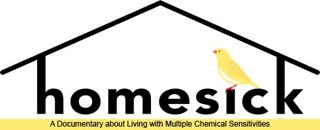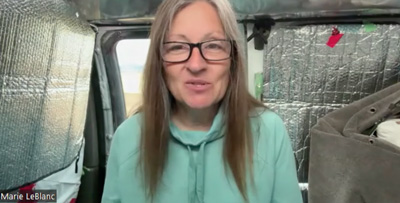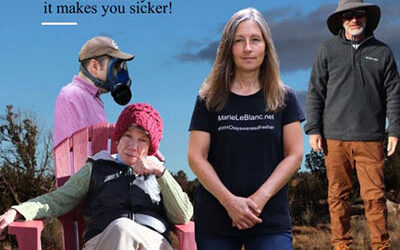by Susan Molloy

Whatever disabling sensitivities we live with, Susan Abod’s autobiographical documentary “Homesick – Living with Multiple Chemical Sensitivities” reflects what we go through to find and defend accessible, affordable, safe housing.
Abod traveled across the Southwest to find out what housing might be available to individuals who had become hypersensitive to chemicals and mold, as she has. She interviewed numerous people with chemical intolerances who’ve landed on their feet and now live in stable homes that meet their individual specs for safety.
Once safely housed, every single person reports at least partial remission of his or her illness or even complete functional recovery.
She interviewed a few other individuals who are still living as runners, searching night by night for a safe enough place to sleep, who are crying out for a way to slow the progression of what has become a downward spiral.
I’ve watched the 56-minute film over and over with various friends who live with chemical and other environmental hypersensitivities, all of whom are familiar with the territory Abod records. For those of us who’ve settled in the southwest deserts, certainly the geography is familiar. But the heartache and fear are familiar too. Many of us barely survived humiliating, perilous rounds of homelessness ourselves, and while we may currently be safely enough housed, we might never shake the symptoms of PTSD.
“Homesick” brings to mind, for me, numerous related issues that beg for our attention. Topics I’d like to see explored, given the resources:
• Securing a safe place to live has at some time entirely dominated the life of nearly everyone living with chemical sensitivities, CFS, electrical hypersensitivity, effects of Lyme/tickbourne diseases, neurological and immune disorders and other effects of poisoning. For now at least, stability, let alone improvement, for these medical conditions is only achievable if a person’s home offers protection against inciting exposures.
• HUD went missing in action for our purposes circa 1995. Prior to that, HUD legal staff had declared that the functional impairments resulting from environmental illness could be disabling, qualifying us for legal protection and assistance in housing. So why, in 25 years, in the entire United States, have we only 11 (somewhat) accessible affordable apartment units and 4 small rental houses built with H.U.D. funds? What would it take, now, for HUD to underscore our right to safe housing by getting up off some cash to generate real housing on the ground?
• Universal Design and “green” housing, and the meager legal requirements for conventionally “Accessible” housing only rarely and incidentally incorporate features that do us any good. This situation persists, despite our decades of grueling work to provide H.U.D., the U.S. Department of Justice, and Green enthusiasts with helpful information. By now, our efforts to “educate” them just feel like “begging” and sadly have not had a meaningful effect.
• A house is only as “safe” as the neighborhood it’s in. Time and again, individuals who finally move into a safe enough place have been effectively evicted, with no notice, maybe ½ hour to pack a few things and get out, and no legal recourse, by a neighbor using dryer sheets, a computer router, lawn care chemicals, or other superficial commercial products. This kind of eviction, that has possibly lethal effects, is illegal to do to anyone else in the United States.
• Like anyone else, we could benefit from the advantages of conventional communities like medical care, stores, schools, wheelchair access, rehab, sidewalks, transportation, cultural connections, 911 Service, police assistance, and all the rest – but to forestall incapacitation we remain segregated. What would be the advantages and disadvantages of enacting protective zoning?
I hope “Homesick” opens a floodgate of films and artwork that focus on our situation. By telling her own story and showing us what she’s seen, Abod adds viability to our subculture, even while we cope with the wreckage of our former dreams.
Many thanks to Susan Abod for her work and to those who lent her support of whatever kind. And thanks to each individual she interviewed, all of who took a personal risk to bring the truths of our housing story closer to the light.
Watch the trailer:
Update: I just got a VM message from Susan Abod, saying the owner of the house she rents has given her notice.
Susan Molloy, M.A. Disability Policy, Snowflake, AZ 85937, (928) 536-4625, [email protected]
To watch the movie online: click here
To order the DVD: click here
To see more footage from the “Homesick” project and referrals for further study see Abod’s website: http://homesick-video.com
E-mail: [email protected] or Phone: (505) 466-1273










Susan this is a wonderful review of the film and summary of topics that deserve sustained attention. I will definitely watch “Homesick”, and know it will affect me powerfully as I still don’t have stable housing myself.
MANY kudos and deepest appreciation to you for the incredible work you’ve done for EIs over the years (decades!), and to Susan Abod for making this important film.
This looks like it’s worth watching, but at $8.95 per viewing, I don’t think I can do it or recommend it to others. Can it be made cheaper to watch somehow?
Hi Bluebird52,
Planet Thrive was not involved with the production of the movie at all and has no control over the pricing. Please contact the creator of the film, Susan Abod, through her website (see link, plus her email and phone number, in article) if you have any questions about the film’s production or distribution. Best, Julie
Thank you, Susan, for this excellent review and commentary. You have been a guiding light and a beacon of hope for all in the MCS community. And I gotta tell you, I don’t put many people on pedestals. Thank you-may you motivate others to follow your formidable and accomplished lead.
Housing has been one of the single most difficult issues facing persons living with MCS/EI. This documentary shows the problem clearly and makes us “feel” the pain a lot of us have suffered with long housing searches and living in substandard conditions. I for one suffered greatly and have watched many of my friends die from not being able to handle the stress of being a sick and homeless person. I too have struggled for years to help create safe housing and yet was not able to do that. I agree with Susan Malloy that HUD needs to step up to the plate on this one and stop ignoring the issue just because it is hard or controversial! Many illnesses are “controversial” (like AIDS), yet they still give those sick with it services.